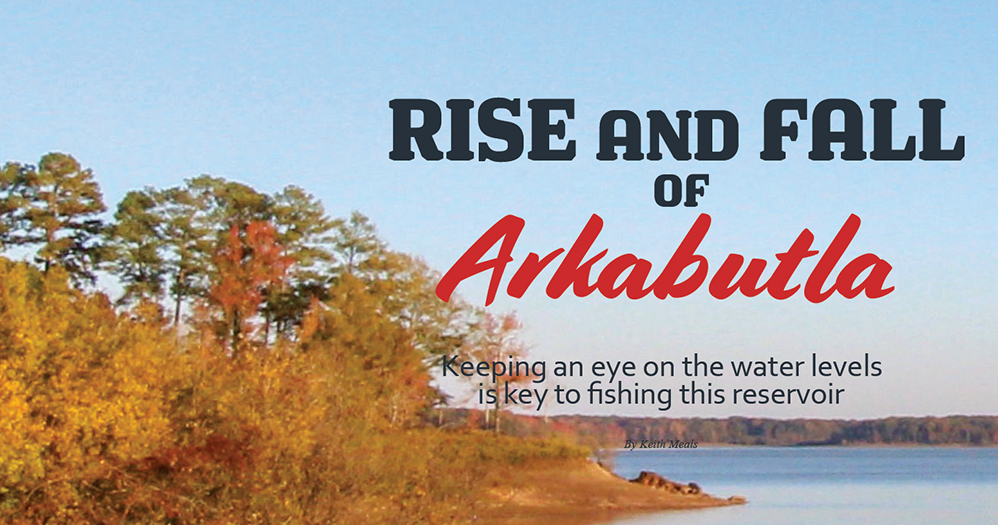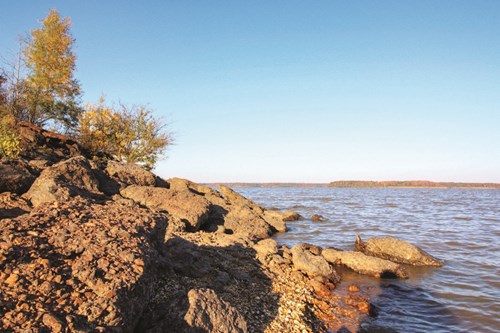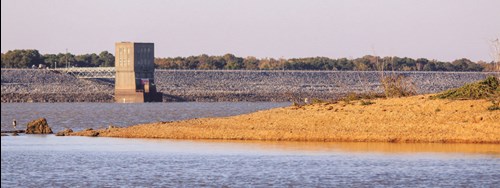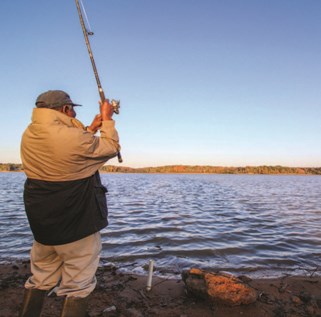Rise and Fall of Arkabutla
2/7/2019 3:14:01 PM
By Keith Meals

Huge crappie, humbling, good catfish, tough, chunky bass, frustrating, plus some less complimentary terms have been used to describe fishing at Arkabutla Reservoir.
Arkabutla, the smallest and shallowest of the “Big Four” northern Mississippi flood control reservoirs (FCRs), is 11,870 acres at summer pool, only about a third the size of more well-known Sardis (32,100 acres) or Grenada (35,820 acres) reservoirs. At summer pool, Arkabutla is shallow, averaging 9.6 feet deep in comparison to Sardis (18.5 feet) and Grenada (15.3 feet).
Understanding the annual water regime on these reservoirs will help you choose productive fishing locations for each season of the year. Water levels are managed to minimize flooding of land downstream of the reservoirs by the U.S. Army Corps of Engineers, according to a “rule curve” based on seasonal rainfall patterns. The FCRs are lowered to winter pool in the fall (dry season) creating storage room to hold water from rainfall events and allowed to fill to summer pool in the spring (wet season). Floods and droughts cause water levels to be over or under the desired water level according to the rule curve. Although there are spillway gates to release water from the FCRs if the water level gets too high, there is no faucet, except rainfall, to fill them if they get too low.

Because of its shallowness and a vast watershed of 1,000 square miles, Arkabutla’s water level fluctuates more than the other FCRs. It has also overflowed its emergency spillway more often than the other FCRs, most recently in 2016. To minimize downstream flooding, Arkabutla is filled later in the year than the other FCRs since the chance of a flooding rain decreases as spring turns to summer. Because of its small volume, it is drawn down a month later in the fall than the other FCRs.
As rainfall runoff happens, the Arkabutla Reservoir can rise above its rule curve, and then is drawn back down, resulting in high water release rates and rapidly fluctuating water levels. Fish in Arkabutla move to find suitable temperatures, food, and habitat as water levels change. Since finding fish is often the biggest obstacle to catching them, these fish movements often result in inconsistent catches that can frustrate and humble even the best anglers.
Historically, Arkabutla was muddy, and fishing effort was meager. However, the reservoir had a reputation for big crappie and good numbers of catfish. It produced the state record black crappie (4 pounds, 4 ounces) from its headwaters in 1991. The first Mississippi Department of Wildlife, Fisheries, and Parks (MDWFP) angler creel survey on Arkabutla was completed in 1994. That survey found 74 percent of anglers were after crappie, 12 percent were fishing for bass, and 9 percent were after catfish. They fished for more than 55,500 hours and harvested 37,000 pounds of fish. More than 80 percent of the harvest, by weight, was crappie that averaged 1.1 pounds with a 10-inch minimum size limit. Fishing pressure was low at 4.4 angler hours per acre.

Over the last 20 years, changing land uses and soil conservation measures have resulted in clearer water in Arkabutla, which benefits the fish population and anglers. The FCRs have nationally ranked fisheries because of changing crappie regulations. Plus, they have been featured in tournaments, magazines, and television fishing shows. Internet websites and social media have ensured there is no such thing as a secret fishing hole, and shared pictures of eye-popping Arkabutla crappie have piqued the interest of far-flung anglers. Also, blue catfish, locally known as “white river cats” or “white humpbacks,” have recently become more abundant on the FCRs.
A 2016 angler survey found Arkabutla anglers fished almost 237,000 hours (more than four times the 1994 effort) and kept nearly 235,000 pounds of fish (more than six times the 1994 harvest). Similar to 1994, 70 percent of anglers were crappie fishing, but 16 percent were catfishing, and only 4 percent were bass fishing. About 59 percent of the harvest, by weight, was crap-pie that averaged 1.4 pounds with a 12-inch minimum size limit. Fishing pressure was 14.4 hours per acre, but it was that low because the water level was high because of the 2016 flood, which vastly increased reservoir acreage. Recently, fishing pressure on Arkabutla has been similar to Enid, Grenada, and Sardis.
The amount of natural structure, like timber and vegetation, changes each year in the FCRs. Pre-impoundment timber continues to die and decay. Creeks and rivers have silted in, cut new channels, been channelized, or re-cut old channels. Areas within the main body of the reservoir have filled in or eroded away. Anglers must adapt to reservoir habitats as they are today, not as they look in memories, maps, or even on their depth-finder’s graphics card.
 Michael Powell, a long-time MDWFP Conservation Officer, lives near Arkabutla and has fished it for many years. He encounters thousands of anglers on the reservoir annually; so to say he knows Arkabutla would be an understatement. His best advice is: “Know where to fish at each water level.” That takes years of experience, and seasonal patterns contribute to this, too. Fish spawn in spring, school in summer, and follow the channels in the primary reservoir during the fall. He also notes that Hurricane Creek is currently the most productive arm of the reservoir because it is the deepest, most well-defined creek.
Michael Powell, a long-time MDWFP Conservation Officer, lives near Arkabutla and has fished it for many years. He encounters thousands of anglers on the reservoir annually; so to say he knows Arkabutla would be an understatement. His best advice is: “Know where to fish at each water level.” That takes years of experience, and seasonal patterns contribute to this, too. Fish spawn in spring, school in summer, and follow the channels in the primary reservoir during the fall. He also notes that Hurricane Creek is currently the most productive arm of the reservoir because it is the deepest, most well-defined creek.
How do fish respond to the various water levels? In high water, fish scatter over thousands of more acres of water than usual and often move into thick, impenetrable cover. A single pole and heavy line “to horse” a slab crappie out of the bushes is the best way to fish this situation. Anglers can pick up a fish here and there while sifting through hundreds of trees, bushes, and areas to figure out a pattern. People say that high water is “good for the fish, bad for the anglers,” but low water can be the opposite. In shallow water, fish are concentrated on limited cover, making them much easier to find and catch. A second example is white bass. These fish spawn in flowing water; they move up tributaries in spring and then head back to the open water of the primary reservoir by summer. The only difference in high and low water for them is how far upstream they swim to spawn.
Knowing the water level trend, especially during the spawn, is extremely important. If the water level is falling, crappie spawn at least 3-5 feet deep to ensure their eggs will not be left high and dry. With rising water levels, they might spawn in water, so shallow their backs are showing. Changing water levels do not influence the catfish spawn because they spawn later in the year when the water level is usually stable.
Some of the best fishing is when high spring water levels are drawn back down to summer pool. As the reservoir shrinks, fish are pulled out of thousands of acres of thick cover and move out of the shade of the bushes into open water. For crappie, trolling outside the tree line is the most productive method. In these years, June or July may bring more crappie fishing effort and harvest than in March or April. Even with average water levels, fall drawdown concentrates fish in the tributaries as they follow the falling water to the main reservoir. Fishing for all species in the fall can be as good as it is in the spring, but with fewer weather changes. Crappie are usually the first to move out to the main reservoir, followed by bass and bream, and then catfish.
Fish shallow at Arkabutla because the fish have nowhere else to go. I have caught bass on buzz baits in July. In winter and spring, the water is usually muddy, so fish hold shallower than in clear water. In summer and fall, the water is less murky, but it develops an algae bloom that reduces sunlight penetration, which keeps the fish shallow.
In muddy water, fish lures with bright colors such as chartreuse, hot pink, or orange with some scent and vibration (minnows, rattles, spinners, etc.), but in clear water, use more subdued colors and vibrations. For catfish, natural baits are always popular. Blue catfish are more likely to bite flavored chicken or cut shad than the chicken liver or worms that channel catfish prefer.
Nothing beats on-the-water experience for improving your fishing success. You can learn faster if you can fish with someone who is familiar with the reservoir but does not “fish out” or advertise the spot. MDWFP's website has fishing reports, which are updated weekly from mid-February through November. The reports also contain links to reservoir water levels and trends. You soon may be hauling in a slab crappie or a fat catfish. Or it might be one of those days when Arkabutla humbles you. It happens to everybody.
Keith Meals is a fisheries biologist with MDWFP.









